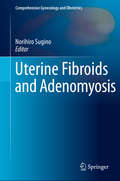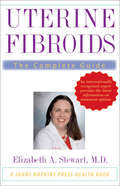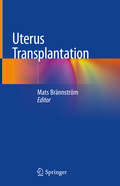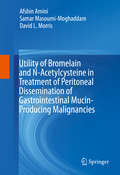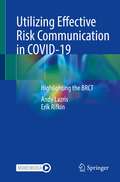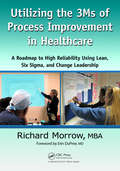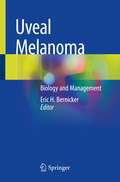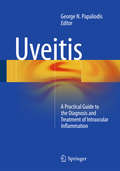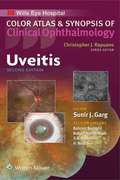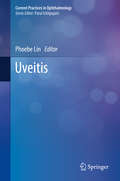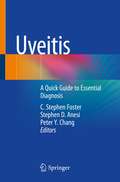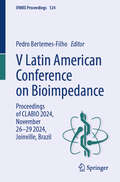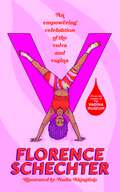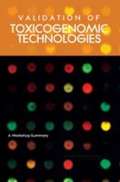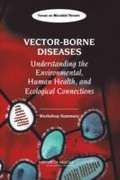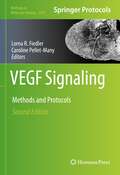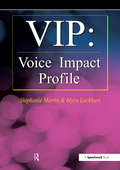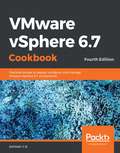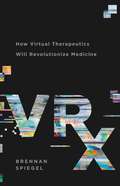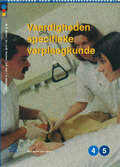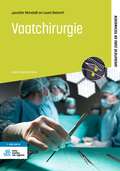- Table View
- List View
Uterine Fibroids and Adenomyosis (Comprehensive Gynecology and Obstetrics)
by Norihiro SuginoThis volume elucidates state-of-the-art findings of uterine fibroids and adenomyosis, incorporating expert basic knowledge. Uterine fibroids and adenomyosis are common uterine tumors in reproductive-age women. However, the pathogenesis of the tumors is still poorly understood, and both genetic and environmental factors may be involved in their generation or development. Recent research on the genomics and molecular biology of uterine fibroids and adenomyosis has facilitated a better understanding of the pathogenesis and pathophysiology of these benign tumors. Renowned experts provide detailed discussions of basic research and clinical aspects of uterine fibroids and adenomyosis in this book, from histopathology and molecular pathogenesis to diagnosis and the latest treatment of uterine fibroids, including pregnancy complications of adenomyosis. A great deal of information and a deep understanding of molecular and genetic biology have led to development of more innovative treatments of these tumors. Thus this book benefits not only oncologists, seasoned gynecologists, and obstetricians, but also molecular biologists and other basic researchers who are involved in the treatment of uterine fibroids.
Uterine Fibroids: The Complete Guide (A Johns Hopkins Press Health Book)
by Elizabeth A. StewartProviding the most reliable and up-to-date information on this very common and difficult disorder, Dr. Stewart helps women understand uterine fibroids and make the best possible choices about their care.You've called in sick today. Your back and legs hurt. Your abdomen is bloated and more than a little uncomfortable. You are having your period, and the bleeding is so heavy you can't even think about leaving the house. You have uterine fibroids.One in every four women see their lives affected by uterine fibroids, which can cause heavy bleeding, abdominal bloating, pain, and infertility. The symptoms can be mildly annoying or life altering in severity. Until recently, hysterectomy was the only way to cure fibroids, and each year more than 200,000 hysterectomies are performed in the United States to treat these noncancerous growths. But hysterectomy isn’t always the best solution. The procedure can be devastating for women who were planning to get pregnant, and it is a significant surgery for anyone. In this comprehensive and compassionate guide, Dr. Elizabeth A. Stewart helps women understand the treatment options now available.An internationally recognized expert on fibroids, Dr. Stewart describes all the available medical and surgical treatments as well as alternative and complementary therapies. In addition to hysterectomy, she explains uterine artery embolization (UAE), noninvasive focused ultrasound (FUS), and innovative hormone treatments. Simple diagrams and photographs illustrate the condition—and its treatment. Dr. Stewart encourages women with fibroids to learn as much as they can before choosing a treatment plan. Providing the most reliable and up-to-date information on this very common and difficult disorder, she helps women understand uterine fibroids and make the best possible choices about their care.
Uterine Myoma, Myomectomy and Minimally Invasive Treatments
by Andrea Tinelli Antonio MalvasiUterine myomas are the most common benign tumors in women, affecting the half of women and mostly in reproductive age. Myomas cause significant morbidity and are the single most common indication for hysterectomy around the world. Thus, myomas represent a major personal and public health concern worldwide. The diagnosis of fibroids can be established based on ultrasound and radiological imaging. Recent research on the genomics and molecular biology of myomas has enabled us to better understand the pathogenesis and pathophysiology of this benign tumor, but more remains to be discovered. In the clinical parterre, novel methods of conservative treatments have been developed to allow many women to keep their reproductive capacity and to save uterus, and more novel treatments are available on the horizon. For this topic, an outstanding group of worldwide experts have come together to provide a detailed discussion of basic research and clinical aspects of myomas. All the existing knowledge will be summarized in this book that can serve as a starting point for clinicians, young doctors, students, fellows and all researchers who want to read up on this disease. This book is devoted to myomas, covering both recent advances in our understanding of their behaviour, and an overview of the current options for their minimally invasive treatments, with endoscopy and new devices. As we learn more about the molecular, genetic and biology of myomas, we will be able to develop more innovative treatments.
Uterine Pathology
by Robert A. Soslow Teri A. LongacrePart of the Cambridge Illustrated Surgical Pathology series, this book provides a comprehensive account of the experienced gynecologic pathologists' diagnostic approach to uterine pathology. Discussion is built around major pathologic entities in the uterus and cervix while highlighting the diverse and complex spectrum of alterations encountered in daily practice. Emphasizing clear description, diagnostic algorithms and problem solving, the book's primary goal is to lay the foundation for diagnostic accuracy, reproducibility, and relevance. It also dispels common misconceptions and encourages an intelligent and thoughtful approach to diagnostic problems using all the tools available to the modern physician. The book is richly illustrated, with more than 700 color photomicrographs, all of which are also found in downloadable format on the accompanying CD-ROM.
Uterus Transplantation
by Mats BrännströmThis book discusses all aspects of the uterus transplantation procedure in women who are childless because of a dysfunctional or missing uterus, from initial pre-operative investigations to follow-up after the uterine graft has been removed. All the international experts who are engaged in clinical activities and/or research in this field have contributed one or more of the book’s chapters. Since the first live birth following uterus transplantation was reported in Sweden in September 2014, the field has been rapidly evolving around the globe: the first cases in USA, Germany, China, Brazil, and Czech Republic were performed in 2016 and several other centres are preparing for clinical trials of uterus transplantation. Uterus transplantation is a subject that attracts the attention of many bioethicists, and like all other major procedures in transplantation surgery and assisted reproduction techniques, it is a complex process that requires a multidisciplinary team if it is to be successful. As such the book is a valuable resource not only for clinicians from many disciplines, but also for nurses, ethicists, psychologists and researchers.
Utility of Bromelain and N-Acetylcysteine in Treatment of Peritoneal Dissemination of Gastrointestinal Mucin-Producing Malignancies
by Afshin Amini Samar Masoumi-Moghaddam David L. MorrisThis volume will describe both growth-inhibitory and mucin-depleting effects of bromelain and N-acetylcysteine, on their own or in combination, in cancer. It will coherently review the pathophysiological aspects of the mucin glycoproteins in malignancies and provide an updated account of the status of bromelain and N-acetylcysteine in cancer therapy. The volume will develop the idea of using these two drugs as a combination formulation for mucin-depleting effects.
Utilizing Effective Risk Communication in COVID-19: Highlighting the BRCT
by Erik Rifkin Andy LazrisThis book demonstrates how a novel decision-aid, called a Benefit-Risk Characterization Theater (BRCT), can be used to:· Significantly improve accurate communication of health risks from exposure to COVID-19; and· Assess how to best contain and control COVID-19.To date, there have been far-reaching ramifications based on ineffective risk communication when clarifying these health endpoints.A BRCT is a familiar, theatrical chart representation of 1,000 people, with the risks and benefits shown by blackened seats. Since health outcomes can easily be put into such a chart, we show how BRCTs can be used objectively by professionals, the media and lay people. It allows characterization and communication of health benefits and risks of COVID-19 treatment and containment in an undemanding and straightforward way.BRCTs have been successfully used to assist patients in determining:· Their level of acceptable risk of various medical interventions;· If the benefits of intervention outweigh the risks;· Who should make the final decision regarding medical intervention; and· Whether the decision is evidence-based.Written by experts in the field, this book fills in a gap in communication between the medical community, the public and patients. It also provides an area of expertise in communication that is beneficial for medical providers and medical students.
Utilizing the 3Ms of Process Improvement in Healthcare: A Roadmap to High Reliability Using Lean, Six Sigma, and Change Leadership
by Richard MorrowUtilizing the 3Ms of Process Improvement in Healthcare supplies step-by-step guidance on how to use the 3Ms of change leadership to improve healthcare processes. Complete with forms, templates, and healthcare case studies, it illustrates the proper application of the 3Ms. It weaves stories throughout the book of role models who have succeeded, as w
Uveal Melanoma: Biology and Management
by Eric H. BernickerThis book provides a comprehensive examination of uveal melanoma, a rare neoplasm that carries a very high mortality and whose natural history makes it fairly unique among adult tumors. Split into three sections, this book explores the basic science behind the disease and inherited genetic syndromes that predispose some patients, as well as the pathology and use of gene expression profiling to determine risk of recurrence. It also focuses on the management of the primary tumor in the eye, including surgical intervention and lesion imaging. Elucidating treatment options for metastatic disease, the book reviews chemotherapy agents and immunotherapy approaches, as well as liver-directed therapies, cellular therapies, and various treatments after primary treatment but before the development of metastases.Uveal Melanoma: Biology and Management is the most up-to-date and comprehensive text devoted solely to this disease and will be useful to medical oncologists, ophthalmologists, radiation therapists, interventional radiologists, pathologists, molecular biologists and immunology researchers, as well as trainees in those fields.
Uveitis
by George N. Papaliodis Uveitis is a practical guide for the diagnosis and treatment of uveitis and ocular inflammatory diseases. This text provides uveitis specialists, practicing ophthalmologists, and ophthalmology residents with the appropriate diagnostic testing and evidenced-based therapeutic options for managing patients afflicted with these conditions. The realm of ocular inflammatory diseases is constantly changing with improved diagnostic modalities and treatment options, however, despite these innovations, the ocular inflammatory diseases, including uveitis, are the third leading cause of blindness worldwide. Written and edited by leaders in the fields of ophthalmology, rheumatology, internal medicine, infectious disease, and oncology, Uveitis addresses the latest advances in the field, from the advent of PCR technology, intraocular depot steroid implants, neoplastic and infectious diseases masquerading as uveitis, and the use of systemic immunomoduatory therapies (including biologic agents/humanized monoclonal antibodies in the armamentarium).
Uveitis (Color Atlas and Synopsis of Clinical Ophthalmology)
by Sunir J. GargPublisher's Note: Products purchased from 3rd Party sellers are not guaranteed by the Publisher for quality, authenticity, or access to any online entitlements included with the product. Developed at Philadelphia’s world-renowned Wills Eye Hospital, the Color Atlas and Synopsis of Clinical Ophthalmology series covers the most clinically relevant aspects of ophthalmology in a highly visual, easy-to-use format. Vibrant, full-color photos and a consistent outline structure present a succinct, high-yield approach to the seven topics covered by this popular series: Cornea, Retina, Glaucoma, Oculoplastics, Neuro-Ophthalmology, Pediatrics, and Uveitis. This in-depth, focused approach makes each volume an excellent companion to the larger Wills Eye Manual as well as a practical stand-alone reference for students, residents, and practitioners in every area of ophthalmology.
Uveitis (Current Practices in Ophthalmology)
by Phoebe LinThis book discusses the main clinical aspects of common uveitic infectious and non-infectious entities, the diagnostic work-up, and the treatment/management options based on the literature, where available, and clinical experience. Providing a quick reference guide to uveitis and retina fellows as well as general ophthalmologists, this comprehensive book includes chapters on diagnostic biopsy and pediatric uveitis, as well as reference tables and figures.As part of the series “Current Practices in Ophthalmology” this book is intended for residents, fellows-in-training, generalist ophthalmologists and specialists alike.
Uveitis: A Quick Guide to Essential Diagnosis (Essentials In Ophthalmology Ser.)
by C. Stephen Foster Stephen D. Anesi Peter Y. ChangFocusing solely on uveitis care, this quick reference guide will provide a compiled and easy to navigate differential diagnosis – making an often daunting task for clinicians easier, quicker, and more accurate by using a concise outline format to list the most critical aspects of a disease entity. Uveitis: A Quick Guide to Essential Diagnosis opens with a Diagnosis Flowchart, so that the reader can select the most probable diagnoses based on patient’s history and exam. From there the reader can then quickly turn to the corresponding chapter to learn about the most critical aspects of the disease entity: epidemiology, characteristic exam and imaging findings, prognostic factors, and treatment options. This book is written for ophthalmic care providers including general ophthalmologists, subspecialists, fellows, residents and optometrists and features research and contributions from institutions that are global leaders in uveitis care.
Uveitis: An Update
by Jyotirmay Biswas Parthopratim Dutta MajumderThis book on recent advances in uveitis provides readers with up-to-date and clinically-relevant information on 18 topics that are indispensable for everyday practice. This book is meant for bridging the gap between recent developments and their incorporation into clinical use. Written by global experts, the topics cover advances in diagnosis and treatment of distinct clinical varieties of uveitis. Additionally, the chapter on imaging describes the various imaging modalities that aid clinching the diagnosis with greater accuracy. Role of corticosteroids, their mechanism of action and various routes of drug delivery too have been discussed in detail. Optimal use of various immunomodulators, their role, dose, mechanism of action, side effects, and monitoring during patient follow-up have been elucidated in easy-to-understand tables. There are two chapters on complications in uveitis, one on glaucoma and other on choroidal neovascularization. A chapter on pediatric uveitis highlights the challenges and provides guidance to manage this special population.
V Latin American Conference on Bioimpedance: Proceedings of CLABIO 2024, November 26-29, 2024, Joinville, Brazil (IFMBE Proceedings #124)
by Pedro Bertemes-FilhoThis book offers a timely snapshot on the developments in the field of bioimpedance, covering diverse applications such as in medicine, food industry and other fields. Gathering the proceedings of the X Latin American Conference on Bioimpedance, CLABIO 2024, held online on November 26-29 2024, from Joinville, Brazil, this book highlights key findings in the field, as well as the results of interdisciplinary discussion between different researchers and stakeholders from the fields of Biomedical Engineering, Medical Physics, Medicine, Environmental Science, Biology, and Chemistry. It offers extensive information on bioimpedance and related technologies, and a lively discussion on future challenges and technologies.
V: An empowering celebration of the vulva and vagina
by Florence SchechterFrom the creator of the world's first Vagina Museum, discover your go-to guide to the vulva.The Vulva. For thousands of years, our vulvas and vaginas have been considered mysterious, taboo and shameful. In fact, 50%* of us, don't even know where the vagina actually is.In this uplifting, informative, witty and empowering guide, we'll explore:- How to label a vulva- The power of periods and the many myths around them- How vulvas have inspired art, folklore and music throughout history and across the world- How to cut through the noise of the feminine hygiene industry- How to feel empowered to call a vulva a vulva!Packed with fascinating contributions from leading activists and experts, V will help every reader discover their own BIG V ENERGY*2021
VALIDATION OF TOXICOGENOMIC TECHNOLOGIES: A Workshop Summary
by National Research Council of the National AcademiesBeginning in the early 1980s, new technologies, began to permit evaluation of the expression of individual genes. Recent technological advances have expanded those evaluations to permit the simultaneous detection of the expression of tens of thousands of genes and to support holistic evaluations of the entire genome. The application of these technologies has enabled researchers to unravel complexities of cell biology and, in conjunction with toxicologic evaluations, the technologies are used to probe and gain insight into questions of toxicologic relevance. As a result, the use of the technologies has become increasingly important for scientists in academia, as well as for the regulatory and drug development process.
VECTOR-BORNE DISEASES: Understanding the Environmental, Human Health, and Ecological Connections
by Institute of Medicine of the National AcademiesThe National Academies Press (NAP)--publisher for the National Academies--publishes more than 200 books a year offering the most authoritative views, definitive information, and groundbreaking recommendations on a wide range of topics in science, engineering, and health. Our books are unique in that they are authored by the nation's leading experts in every scientific field.
VEGF Signaling: Methods and Protocols (Methods in Molecular Biology #2475)
by Lorna R. Fiedler Caroline Pellet-ManyThis volume provides an updated collection of protocols for manipulating and studying VEGF signaling pathways in vitro and in vivo and aims to present a range of both firmly established and newly emerging technologies. Covering multiple model species, from mouse to zebrafish to human, the book explores the role of VEGF and VEGFR isoforms in exosomes, cultured cells, or in tissues, as well as robust cell assays for the investigation of basic angiogenic mechanisms and VEGF signaling in more complex cellular systems, amongst other subjects. Written for the highly successful Methods in Molecular Biology series, chapters include introductions to their respective topics, lists of the necessary materials and reagents, step-by-step, readily reproducible laboratory protocols, and tips on troubleshooting and avoiding known pitfalls. Authoritative and up-to-date, VEGF Signaling: Methods and Protocols, Second Edition provides a useful tool for researchers in the vascular biology community and beyond in understanding the basic biology of VEGF signaling and in translating this research into the clinic.
VIP: Voice Impact Profile
by Stephanie Martin Myra LockhartThe "VIP" is a user-friendly, point-in-time assessment tool which provides an 'at a glance' vocal profile for the clinician, voice coach and client. It examines the potential impact of a number of specific factors on the voice: general health; vocal history; vocal health; voice care; vocal status; voice genogram; anxiety and stress; social functioning; vocal demand; and environmental factors, and offers an overview of the theory to support this choice. The questions have been carefully designed to elicit easily-recorded information from the client about a range of factors that are known to affect vocal quality. The tick-box answers then translate into the Vocal Impact Profile, a visual presentation of the areas of greatest impact on voice. In addition to offering a point-in-time profile, the "VIP" may also be used as a template for achieving change in a specific area of vulnerability and provide a robust visual reinforcement of that change over time. It is, therefore, helpful as a therapy-monitoring tool and as an evaluation of client awareness, behavioural change and clinical effectiveness. Self-administered by the client, the questionnaire should take approximately ten to fifteen minutes to complete. The clinician or voice coach enters the responses into the computer programme (supplied on CD-ROM) or transfers them manually on to the hard copy thus offering a clear visual representation of the results. Worked examples of the VIP are included, presenting six clients with very different aetiologies and with a range of vocal problems. These examples clearly demonstrate the value of the Profile and its visual impact. As a clinical tool the "VIP" provides a subjective qualitative measure, which may be used as an adjunct to other assessment procedures. In addition, it provides a concrete method of determining and ordering the factors to be targeted in terms of therapy or voice work. Using the "VIP" should shorten the time necessary for completion of case history in the case of a voice therapy client, and, when used by a voice coach, the profile will identify areas for further discussion. The Profile is not time-sensitive so it may be repeated to evaluate client awareness of vocal change and implementation of agreed strategies. The "VIP" provides the clinician or voice coach with an efficient and effective means of auditing the therapy or coaching process and promotes a holistic partnership model of intervention.
VMware vSphere 6.7 Cookbook: Practical recipes to deploy, configure, and manage VMware vSphere 6.7 components, 4th Edition
by Abhilash G BProven, actionable ways to install, manage, secure and monitor your vSphere 6.7 environments Key Features Get up to speed with the installation and life cycle management of a vSphere 6.7 environment, using a task-based approach Secure your vSphere environment using SSL Certificates Get introduced to the tools that are used to monitor the performance of the vSphere Environment Book Description VMware vSphere is the most comprehensive core suite of SDDC solutions on the market. It helps transform data centers into simplified on-premises private cloud infrastructures. This edition of the book focuses on the latest version, vSphere 6.7. The books starts with chapters covering the greenfield deployment of vSphere 6.7 components and the upgrade of existing vSphere components to 6.7. You will then learn how to configure storage and network access for a vSphere environment. Get to grips with optimizing your vSphere environment for resource distribution and utilization using features such as DRS and DPM, along with enabling high availability for vSphere components using vSphere HA, VMware FT, and VCHA. Then, you will learn how to facilitate large-scale deployment of stateless/stateful ESXi hosts using Auto Deploy. Finally, you will explore how to upgrade/patch a vSphere environment using vSphere Update Manager, secure it using SSL certificates, and then monitor its performance with tools such as vSphere Performance Charts and esxtop. By the end of this book, you'll be well versed in the core functionalities of vSphere 6.7 and be able to effectively deploy, manage, secure, and monitor your environment. What you will learn Deploy a new vSphere 6.7 environment or upgrade an existing vSphere environment to version 6.7 Learn how to configure and manage storage and network access for a vSphere environment Enable high availability for Hosts, VMs and vCenter Server Optimize your vSphere environment for resource distribution/utilization Patch or upgrade a vSphere environment using vSphere Update Manager Secure vSphere infrastructure components using SSL certificates Effectively monitor the performance of your vSphere environment Who this book is for If you are a systems administrator, support engineer, or anyone who wants to learn how to install, configure, and manage a vSphere environment in a quick, hands-on manner, then this book is for you. Consultants and infrastructure architects who wish to design and deploy vSphere 6.7 environments will also find this book helpful.
VRx: How Virtual Therapeutics Will Revolutionize Medicine
by Brennan SpiegelA leading doctor unveils the groundbreaking potential of virtual medicine.Brennan Spiegel has spent years studying the medical power of the mind, and in VRx he reveals a revolutionary new kind of care: virtual medicine. It offers the possibility of treating illnesses without solely relying on intrusive surgeries or addictive opioids.Virtual medicine works by convincing your body that it's somewhere, or something, it isn't. It's affordable, widely available, and has already proved effective against everything from burn injuries to stroke to PTSD. Spiegel shows how a simple VR headset lets a patient with schizophrenia confront the demon in his head, how dementia patients regain function in a life-size virtual town, and how vivid simulations of patients' experiences are making doctors more empathic.VRx is a revelatory account of the connection between our bodies and ourselves. In an age of overmedication and depersonalized care, it offers no less than a new way to heal.
Vaardigheden specifieke verpleegkunde: Niveau 4 en 5
by I. Oldenburger De Jong Consulting B.V. J.A.M. Kerstens M.R. Bouma L.D. Klei.
Vaatchirurgie (Operatieve zorg en technieken)
by Jennifer Mandelli Leoni ReimertIn deze vijfde, volledig herziene druk van Vaatchirurgie worden de volgende onderwerpen behandeld: Het eerste hoofdstuk gaat in op algemene vaatchirurgische principes en de mogelijkheden voor diagnostiek. De volgende hoofdstukken behandelen achtereenvolgens carotis chirurgie, dialyse chirurgie, thoracale, abdominale en perifere vaatchirurgie, amputaties en transplantatie chirurgie. Het boek heeft een uitgebreide update van de endovasculaire principes gekregen. Het is geschreven voor operatieassistenten in opleiding. Tevens kan dit boek dienst doen als naslagwerk voor medewerkers op de operatiekamer en voor verpleegkundigen die werkzaam zijn op chirurgische verpleegafdelingen waar vaatchirurgische patiënten worden verpleegd.De reeks ‘Operatieve Zorg en Technieken’ is bestemd voor de opleiding tot operatieassistent. Naast het basisboek bestaat de reeks uit een aantal vervolgdelen, waarin de verschillende subspecialismen van de chirurgie worden behandeld. Elk deel in de reeks heeft dezelfde indeling. De operatiebeschrijvingen zijn onderverdeeld in de pre-, per- en postoperatieve fase. De operatie-indicatie en het doel van de operatie wordt voor iedere beschrijving vermeld. Achter in het boek wordt altijd een selectie opgenomen van veelvoorkomend specifiek instrumentarium.De reeks ‘Operatieve Zorg en Technieken’ benadert de beroepsuitoefening van de operatieassistent zo dicht mogelijk. De talrijke afbeeldingen onderbouwen deze benadering.
Vaatchirurgie (Operatieve zorg en technieken)
by Jennifer Mandelli Leoni ReimertDit leerboek biedt inzicht in de theoretische en praktische aspecten van de vaatchirurgie.Het boek is geschreven voor operatieassistenten in opleiding. De achtergrondinformatieen de beschreven pre-, per-, en postoperatieve fasen van de operaties kunnen bijdragenaan de benodigde (praktische) kennis. Tevens kan dit boek dienen als naslagwerk voormedewerkers op de operatiekamer en voor verpleegkundigen die werkzaam zijn opchirurgische verpleegafdelingen waar vaatchirurgische patiënten worden verpleegd.Deze zesde, herziene druk van Vaatchirurgie is opgedeeld in drie delen. Het eerste deelgaat in op de algemene vaatchirurgische basiskennis, de vaatchirurgische principes, demogelijkheden voor diagnostiek en de vaatpatiënt. Deze informatie komt ook terugin de andere hoofdstukken van het boek. In het tweede deel worden achtereenvolgenscarotischirurgie, dialysechirurgie, thoracale, abdominale en perifere vaatchirurgie,amputaties en orgaandonatiechirurgie behandeld. Zowel de open chirurgische techniekenals de gesloten endovasculaire technieken worden beschreven. In het derde deelkomt veel voorkomend specifiek instrumentarium aan bod.Nieuw in de zesde druk is de toevoeging van de operatiebeschrijving van het thoracoabdominale aneurysma en het iliacale en poplitea aneurysma. Tevens is er meer aandacht voor andere facetten van een vaatpatiënt en is er meer uitleg over endovasculaire materialen.Online is het complete boek beschikbaar via de code die is opgenomen in het boek.De reeks ‘Operatieve Zorg en Technieken’ is bestemd voor de opleiding tot operatieassistent. Naast het basisboek bestaat de reeks uit een aantal vervolgdelen, waarin de verschillende specialismen van de chirurgie worden behandeld.Deze reeks benadert de beroepsuitoefening van de operatieassistent zo dicht mogelijk,waarbij de gebruikte illustraties en afbeeldingen deze benadering ondersteunen.
